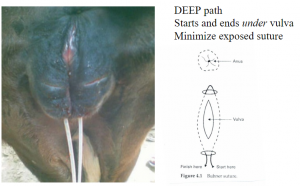Female urogenital surgery
How to – Buhner stitch
Indications
A Buhner stitch is used for vaginal prolapse retention. It can be used short term until a more permanent procedure can be performed in beef cattle and embryo flush cows or can be used as the primary control method in dairy cattle with monitored calving.
Relevant anatomy
The Buhner stitch is placed deeply around the vulva, exiting the perineal body dorsally and the subcutaneous tissues ventrally.
Preoperative management
Food restrictions: NA
NSAIDs/analgesics: NSAIDs are recommended.
Antibiotics:NA
Local blocks: Epidural or pudendal nerve block
Position/preparation: The cow is restrained in a standing position. Sedation is not usually required
Surgery Supplies:
- Buhner needle
- Scalpel blade
- Umbilical tape
Surgical procedure
A 1cm full thickness skin incision is made just below the vulva at the 5:00 position. The Buhner needle is inserted in this incision and directed upwards. The vulvar skin is manipulated on the Buhner needle until the needle exits dorsally above the vulva and below the anus. A 1 cm skin incision can be made horizontally above the vulva to make it easier to exit the needle. Once the needle is exteriorized, umbilical tape is threaded through the opening in the needle. The needle and tape are pulled ventrally so that one end of the tape exits the original incision. A long strand is left exiting from the dorsal incision.

The procedure is repeated on the opposite site starting with a 1cm incision at 7:00 and exiting out the same dorsal incision. The dorsal free end of the umbilical tape is threaded through the needle and pulled down through the ventral incision.
The two strands of umbilical tape are tied in a bow, tightly enough to keep the prolapse inside the vagina but loosely enough to allow urination. Having separate ventral incisions makes it easier to remove the umbilical tape when needed (it stays superficial in this area).
NEW: tie at 3pm vs 6pm to make more visible and remind everyone it is there
Postoperative care
- The tape must be removed prior to parturition.
Complications
- Localized infection (and odor) will develop
- Trauma to dam and baby if the tape is in place during parturition

